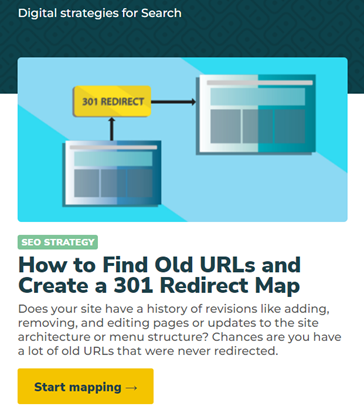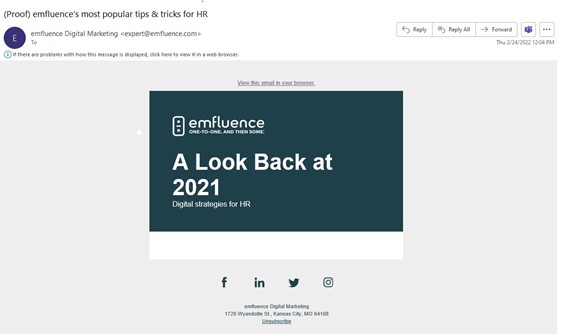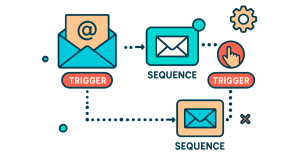The best part about working in marketing is that we’re often trailblazers in our industry, with opportunities to test out strategies and discover new ways to connect with audiences. Our work each day centers around data-driven creativity.
We spent the earlier part of this year focusing on personalization, sharing and learning about the importance of tailored copy in marketing efforts. We took what we said to heart and did some of our own testing to gain insights on the impact of customizing our marketing messages. By playing with dynamic content, we found that personalization works and we’re here to share the results with you!
Getting Started with Dynamic Content Testing
Dynamic content is one method of personalizing your emails simply by adding variables that dictate what pre-determined content a recipient will see. These variables can literally be any subscriber data that you have, whether it’s based on demographic, firmographic, behavioral, or psychographic related factors.
The sky is honestly the limit and there are a lot of unique ways you can personalize using dynamic content. However, the caveat with this is that you need to have the data in order to get anywhere—more on that later.
The Details

For this specific test, we used a specially curated email, “A Look Back at 2021”, that included a sampling of the top blog articles we had written in the past year that touch on various digital strategies. When it cameto dynamic content, we had two areas that incorporated content variables. The first place of personalization was found in the subject line, where we swapped out a generic greeting and included the recipient’s department name— “sales,” “content,” “leadership,” etc. The second area was in the email itself where we selected specific topics related to each person’s department and used conditional content to show them a few articles relevant to their job function. For example, a salesperson received sales related blog topics from 2021 and a CRM person received CRM related blog topics.
On the other hand, our control email—the email to test and compare against—contained only static content and a standard subject line with a few pre-selected, top-ranked 2021 blogs that would not change based on who was opening the email.
To make this test happen, we needed to have a list of recipients to send emails to and a list of blog articles to share.
The process for kicking this entire test off involved some upfront manual work. While we had titles of each person in our newsletter subscriber database, we did not have the actual departments these people worked in. As a result, we took the scrappy route by going through our list and hand sorting everyone into one of nine department categories based on certain assumptions. These departments were:
- Sales
- Leadership
- Marketing
- Search
- Website Development
- Content
- CRM
- Design
Those who fell onto this list received the dynamic email while anyone who didn’t fall into these categories or were listed under “other” received the static email.
Selecting the blogs was a much quicker process. Using Google Analytics, we sorted for top-ranking articles we published in 2021 and picked out the best performing blogs to share with each department category.

Those with “VP” in their title were categorized as “leadership” and would receive emsights that covered everything from top and bottom down marketing to iOS 15 updates. Those with “SEO” in their title were categorized as “search” and would receive search-related topics such as images impacting SEO rankings and 301 redirect maps. We continued working through the list until we had selected the most relevant posts for each department.
The Results
This is the part where we ask for a drumroll, please.
Surprisingly, a lot of people viewed the emails on the web and unsurprisingly, Gmail was the top email client sent to. Overall, views, unique clicks, and clicks-to-views were higher for the email with dynamic content than the email with static content. This lines up with what marketers have been saying and stressing for years—personalization works!
Compared to the static email, the dynamic email had a 5.2 percent increase in unique views and just over double the percentage of unique clicks. Clicks-to-views performed just as well in the dynamic email as opposed to the static email, with a 6.4 percent increase. Long story short, we were excited about the results.
Key Takeaways
Even with a singular email test, we were able to gather important information to take into account when putting together future marketing campaigns.
For one, personalization leads to a significant increase in engagement and is worth the effort. Like we mentioned before, the caveat is that data is necessary to perform some level of personalization and there’s no way around it. However, there are ways to be creative in obtaining and organizing data even if you don’t have dedicated resources or the information you need. Marketing teams everywhere have taken a hands-on approach to this to show executive teams the value and returns that are possible when you do invest in the resources.
One of our account managers actually spent a full day or two sorting through our database and farming out names for each department category. While this took much more effort initially, it proved that taking the extra time to do so pays off and leads to more engagement. From here, we can launch future campaigns asking people to include or update their department information or a consistent annual/ semi-annual/quarterly newsletter of a top blogs roundup.
An additional takeaway and tip we can offer when it comes to personalization is to always proof variable content for every possible iteration. For example, proofing 9 + 1 emails for the nine departments we chose in addition to the static email we were sending out as our control was not enough to catch potential mistakes. Originally the email was being sent out to everyone that had a value for department included in their contact record, but we only created conditional content for nine departments. This led to an email personalized for HR to show up blank with no blog content in it. The lesson here is to check and then double check so you’re confident in what you’re sending out.

Personalization is such a cool aspect of marketing that we’re able to incorporate in campaigns regardless of the high-tech resources we have or the lack thereof. Sometimes it just comes down to setting aside a chunk of time to sit and sort through data in a spreadsheet. When you’re willing to put in the effort, you’ll see promising results.


